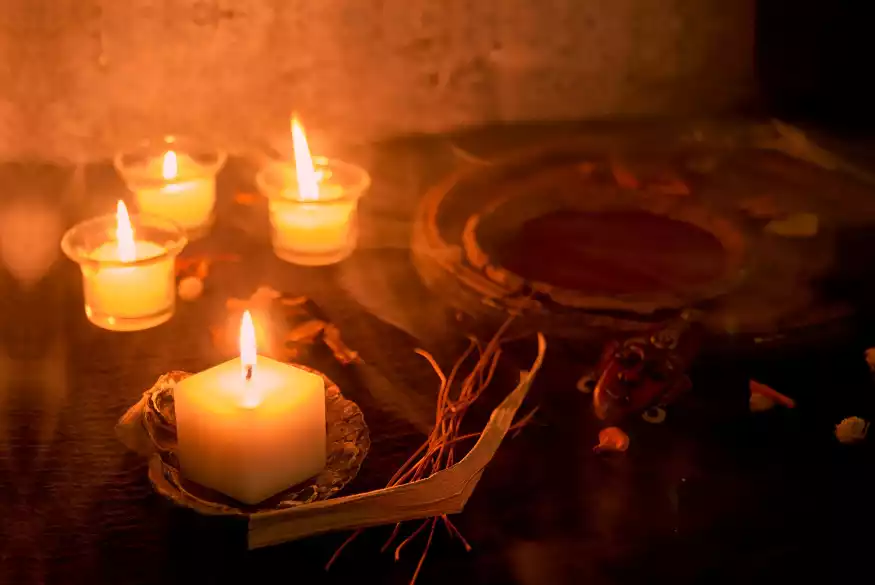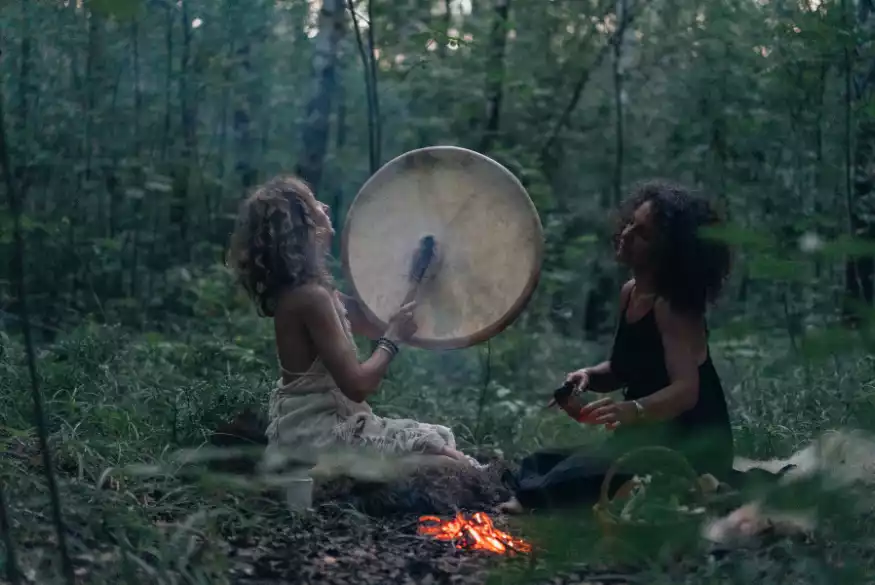Table of Contents
The Santeria religion is a syncretic faith that combines elements of West African and Caribbean religions, with some influence from Christianity. It is based on the worship of the Orisha, or deities, which are spirits associated with natural forces. This religion is followed by millions of people throughout Latin America, the Caribbean, and parts of the United States.
Santeria has roots in the Yoruba religion brought by African slaves to Cuba in the 16th century. It was initially practiced in secret due to suppression from colonial powers. In order for enslaved Africans to practice their beliefs without being detected, rituals and symbols were adapted to resemble those of Catholicism. Over time this led to syncretism –the melding of two different religious systems– between African religions and Christianity. Therefore, many Santeria rituals involve both Catholic prayers and African chants and offerings.
Santeria has its own set of deities and different forms of worship, along with its own set of holidays and rituals. The practice of Santeria involves receiving divine guidance from the gods and spirits, divination, and healing by using herbs, oils, and candles. Additionally, the principles of Santeria involve the Ocha or Orishas, which are gods or spirits that bring good luck, health, and abundance. Moreover, its practitioners believe in reincarnation, ancestor worship, and the power of sacrifice.
Introduction to the Orishas of Santeria
The Orishas, also known as divinities or gods, are part of the religion of Santeria or Lukumi, a syncretized religion practiced in the Caribbean and Latin America. Santeria is a combination of the Yoruba religion of Southwestern Nigeria and the Caribbean religions brought to the New World by African slaves. The Orishas are considered aspects of the Supreme Being, and they are identified with Catholic saints, linking the Catholic faith to traditional African religion. The Orishas are typically connected with a specific day, color, and animal, though these vary among practitioners.
Santeria is a syncretic religion and set of spiritual practices originating in West Africa, incorporating elements of Roman Catholicism and traditional Yoruba beliefs. Santeria, Obeah, and Voodoo all recognize and pay homage to a diverse pantheon of deities, orishas, and spirits who are believed to hold power over different aspects of life on earth.
The Orishas are seen as the intermediaries between humans and the divine and are thus venerated and honored by practitioners. Here is a list of some of the Orishas in Santeria:
Olorun – Sky God, the ruler of the universe
Olorun is the Supreme God, the Creator, and the one who granted the Orishas their power. He is the source of all spiritual and physical energy in the universe. He is worshipped through prayer, song, and offerings.
Obatala – God of creation, protector of kings
Obatala is the Orisha of order and justice and the leader of the Orishas. He is the Orisha of the mind and the spirit and is in charge of all creative endeavors. Obatala is the Orisha of creation, and he is often seen as the father of the Orishas. He is associated with purity, justice, mercy, and truth.
Yemaya – Mother of the living, goddess of the seas
Yemaya is the Orisha of the ocean, and her colors are blue and white. She is the mother of all Orishas and is seen as a loving and compassionate figure. She is associated with fertility and protection, and her offerings often involve placing offerings in the ocean. Yemaya is also known as the protector of women and is said to be a source of comfort and aid in times of need.
Ogun – God of Iron, guardian of the crossroads
Ogun is the Orisha of iron, war, and technology. He is the protector of the people, and he is known for his strength and courage. Ogun is the one who brings peace, victory, and wealth. Ogun is the patron of artisans, and he can bring good fortune to those who are devoted to him.
Shango – God of Thunder and Lightning
Shango is the god of thunder and lightning and is associated with justice and power. He is honored during festivals and ceremonies, and one of his symbols is the double-headed axe. His colors are red and white, and he is often depicted with a folding fan and a staff. Shango is believed to have brought fire and thunder to the earth, to have cleared forests, and to have created over 10,000 languages.
Oshun – Goddess of Love, Beauty, and Sweet Waters
Oshun is the Orisha of love, fertility, and beauty. She is the goddess of the river and the ruler of sweet waters. She is the patron of women and the protector of marriage. Oshun is the mother of the Yoruba people, and she brings luck, success, wealth, and harmony to all who seek her favor.
Babalu-Aye – God of the Sick and Injured
Babalu-Aye (also known as Babalú Ayé or Babalu Aye) is an Orisha, or African deity, in the Yoruba religion. He is associated with healing, protection, and purification through sacrifice. He is often represented as a crippled old man and is associated with the Earth and all who are sick or infirm. He is known as the caretaker of humanity and is deeply committed to healing the sick and suffering. He is also said to be a powerful warrior who is ready to fight for justice and those who suffer from oppression. He is often prayed to for protection against illness and healing of the sick and afflicted.
Oya – Goddess of the Wind, Fire, and War
Oya is an orisha in the religion of Santeria. She is the patron of cemeteries, the dead, and thunderstorms. She is seen as a powerful force of nature and often represents power, aggression, and the willingness to fight for the oppressed. Her colors are brown and purple, and she is commonly associated with the wind, fire, and magic. She is considered to be a fierce warrior and is often depicted riding a horse and carrying a sword or machete. Oya is the protector of women, the wounded, and the unconquered.
Eshu – God of Trickery and Mischief
Eshu is one of the most important of the orishas, or deities, in the Santeria religion. He is the trickster god who is known for his mercurial and unpredictable nature. He is sometimes referred to as the guardian of the crossroads, as he is believed to watch over the transitions between this world and the spiritual realm. Eshu is the deity of justice and balance and is responsible for protecting practitioners of Santeria and being an intermediary between this world and the spiritual world. He is often associated with the colors red and black and is typically portrayed as an old man with a cane, hat, and staff. Eshu is an essential figure in Santeria and is respected and venerated by practitioners of the religion.
Oba – God of Kingship and Authority
In Santeria, Oba is a powerful protector associated with the Yoruba river deity Oshun. Oba is known as a loving, compassionate entity that is devoted to protecting and providing for those who turn to her for help. She is associated with the color white, and her symbols include a white chain and a white rose. Oba is also known for her healing powers and for her ability to help people with fertility, love, and luck. She is also known for her mercy and is said to bring peace and joy to those who venerate her.
Orunmila – God of Wisdom and Divination
Orunmila, known as the Father of Destiny, is one of the most important Orisha of the Santeria religion. He is often seen as the counselor who brings spiritual guidance and insight to his followers. He is a highly revered Orisha and is credited with creating the universe, overseeing the destiny of humanity, and bringing knowledge and justice. He is associated with wisdom, divination, and the ability to see all of the potential outcomes of any given situation. His role is to help his followers make wise decisions and guide them on the path to true happiness and enlightenment.
Ibeji – Twins of the Orishas, bringers of luck and health
The orisha Ibeji is a dual deity in the Yoruba religion of Santeria. It consists of two twins, one male, and one female, who are both aspects of the same god. Ibeji is worshipped as the protector of children, as well as the guardian of the dead. In addition, Ibeji is associated with healing, fertility, and prosperity. Devotees of Ibeji use rituals, offerings, divination, and music to express their devotion and seek blessings from the dual deity.
The Belief
Santeria focuses on the energy that flows through all things, called ashe or aché (“life force”). This energy can be used for good or bad depending on how it is channeled by priests (called Santeros) or priestesses (called Santeras). The goal of practitioners is to bring balance between these forces, allowing them to reach a state of harmony with nature and spiritual growth. Practitioners believe that by honoring their gods, they will receive blessings in return, such as luck, health, or protection from evil spirits.
The Practice of Santeria

Rituals are performed according to an individual’s needs; for example, healthcare rituals may be done to heal an illness or injury, and protection rituals may be done to ward off negative energies. Animal sacrifices are often involved during ceremonies as offerings for the Orishas, and divination readings are used to obtain guidance from higher powers. Ceremonies occur within shrines called igbodu, where altars are adorned with food offerings (ebó), and candles representing each deity are lit up while incantations are recited in a language known as Lucumí -a mixture of Spanish words and ancient Yoruba phrases-. Materials such as wood carvings depicting figures related to each deity can also be found within these spiritual spaces.
The central tenet of Santeria is that if devotees practice reverence for their gods diligently, positive outcomes will result in all areas of life –health-wise, socially, and professionally-. Followers view this faith not only as a way towards self-transformation but also as an essential source providing meaning and purpose in life -in other words: success comes when we stay aligned with our divine path-. As part of its core values, it teaches respect towards others no matter their beliefs since it centers around the idea that interconnectedness is what binds us together as we strive for ultimate enlightenment.
Working with Spells in the Santeria Tradition
Spell casting in Santeria involves using the power of natural elements such as herbs, plants, and stones to create a powerful spell or charm that can be used to bring about positive change in someone’s life. Spell casting also involves invoking the energies of deities or spirits from the Yoruba pantheon, which are believed to have special powers and abilities that can be used for good.
Santeria spells involve creating a sacred space where energy can be focused and directed toward achieving specific goals. This includes preparing candles, incense sticks, oils, crystals, and other items with spiritual significance. The caster then invokes the gods by calling upon them through prayer or chanting special words known only to those initiated into Santeria practices. After this invocation is done, the caster begins working with different symbols associated with each deity before finally performing a ritualistic act designed to influence events according to his will.
Spells cast within Santeria traditions often involve offerings made directly to certain deities in order for them to grant favors or provide protection against negative influences. Offerings may include food items such as fruits, vegetables, and grains, as well as other items such as jewelry or coins. Once the offering is made, the caster then speaks words of gratitude and petitions the gods to grant his requests. The ritual may also involve creating an effigy that represents a particular deity and using it as a focus for further spell-casting activities. After all these steps are completed, the caster awaits the results of the spell casting. If successful, the desired outcome should manifest in due time.
Finally, it is important to remember that when invoking Santeria spells, one must remain humble and respectful of the gods and spirits being petitioned for assistance. It is also essential to keep an open mind and be willing to accept whatever outcome arises, as it is believed that the gods will not grant any request that is not in a person’s best interests. Ultimately, Santeria spell casting should be used judiciously and with caution, reflecting upon how our actions can affect others. With faith and dedication, practitioners may succeed when working with these powerful magical forces.
Comparing Santeria and Wicca – What are the Differences?

Santeria and Wicca are two popular religions that have many similarities but also some distinct differences.
Santeria is an Afro-Caribbean religious belief system mainly practiced in Cuba and parts of Latin America. It combines African and Catholic beliefs and rituals with the primary purpose of connecting to various African ancestral spirits. It uses divination, sacrifice, and drumming as the main components of worship.
On the other hand, Wicca is a modern Pagan religion from Europe that has many different branches, each with its own practices and beliefs. The core element of it is reverence for nature and favoring ethical living over blind obedience to authority or tradition. Rituals often include visualizations, chanting, traditional seasonal festivals, and spell casting, among other things. At the heart of it all is the goal to bring balance and harmony between individuals, society, nature, and the divine beings that inhabit them all.
Ultimately both Santeria and Wicca are about seeking connection with divine forces as part of a spiritual journey. However, their approaches differ greatly due to cultural roots and varying religious practices. While Santeria practitioners seek to connect with specific deities in order to access supernatural powers or cures for ailments, some forms of Wicca focus on opening up portals towards personal growth without any direct interaction with deities or ritual elements traditionally found in Santeria practice.
In Conclusion
In conclusion, Santeria is a complex religious practice that has evolved over centuries and is still practiced today. It is a vibrant and essential part of the culture and history of many countries in the Caribbean and Latin America. Santeria draws from multiple traditions, such as Christianity, African religions, and Indigenous religions, to create unique and powerful spiritual practices. While it is still considered a controversial religion by some, it is important to remember that Santeria is a legitimate religion that is practiced by many people with deep faith and devotion. Therefore, it is important to respect and appreciate the beliefs and practices of Santeria, as well as its many positive influences on the culture and history of the Caribbean and Latin America.
High Priestess Memoona is a well-known and respected spell caster and magical practitioner with more than five decades of experience. She is a master of her craft, having used her powerful abilities to bring people joy, unconditional love, and prosperity. With her unique approach to spell casting, High Priestess Memoona has helped countless individuals manifest their life dreams and achieve their goals. Her expertise and dedication to the craft have made her a highly sought-after Spell Caster, and she is proud to be able to offer her services to those who seek her aid.

